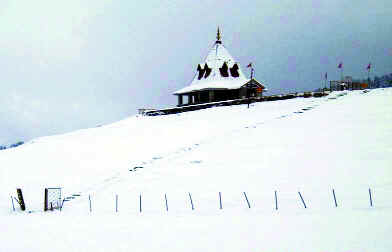Maharani Temple
Maharani Temple
The Maharani temple also known as Mohineshwar Shivalalaya was built by Mohini Bai Sisodhia, the wife of erstwhile ruler of Jammu and Kashmir Maharaja Hari Singh (the last king of Kashmir) in 1915. Mohini Bai Sisodhia was the daughter of Maharaja Mohandev of Dharampur.
"Jai Jai Shiv Shankar, Kanta Lage Naa Kankar, Ke Pyala Tere Naam Ka Piya..Jai Jai Shiv Shankar...". Perhaps not a single old movies' buff can forget this beautiful song picturised in the sylvan settings of Kashmir. Though many would still be aware of the fact that the song from yesteryears' blockbuster "Aap Ki Kasam" starring Rajesh Khanna and Mumtaz was shot in Gulmarg, there won't be many who would know that the temple outside which the duo swung their hips to the popular number, was actually shot outside the famous historic Shiva Temple which was also the Royal temple of the Dogra kings of Jammu and Kashmir.
Gulmarg's legendary beauty, prime location and proximity to Srinagar naturally makes it one of the premier hill resorts in the country. But the presence of a unique temple of Lord Shiva known as "Rani Temple" or "Maharani Temple" makes Gulmarg somehow unique and special.
Situated on a small hillock at the centre of Gulmarg, a unique thing about this Royal temple is the fact that it is seen from all the corners of Gulmarg. The Maharani temple also known as Mohineshwar Shivalalaya was built by Mohini Bai Sisodhia, the wife of the erstwhile ruler of Jammu and Kashmir Maharaja Hari Singh (the last king of Kashmir) in 1915. Mohini Bai Sisodhia was the daughter of Maharaja Mohandev of Dharampur. When the last Dogra king would spent his time in Gulmarg in his royal palace which is situated a couple of kilometers from this temple, the Queen would come here to worship Lord Shiva. Infact, she would stay here for months and worship the Lord in this temple.
The temple which houses a Shiv Lingam and an idol of Goddess Parvati is now being looked after by Ghulam Mohammad Shiekh, a Kashmiri Muslim. After the exodus of Kashmiri Pandits from the valley in early 90's, there was nobody to look after the temple. The Shiekh's father Gulam Rasool Shiekh was the Chowkidar of the temple for about 40 years. That is how he starting taking care of the temple in the absence of a regular priest. Besides performing his duties as a "Pujari" offering the "Prasad" to the devotees and army personnel who throng this ancient temple in big numbers, especially in summers when the place comes alive, he also performs Aarti at the temple.
Managing the affairs of the 92-year old temple for the last 17 years is not an easy job. But he has continued with it despite threats from various quarters. The Shiekh who is well-versed in both Gita and Quran, himself offers Namaaz regularly.
The Dugger Division which is headquartered at Baramulla renovated the temple in 1998 which is being managed by the Jammu and Kashmir Dharmarth Trust headed by Dr Karan Singh, son of Maharaja Hari Singh.

